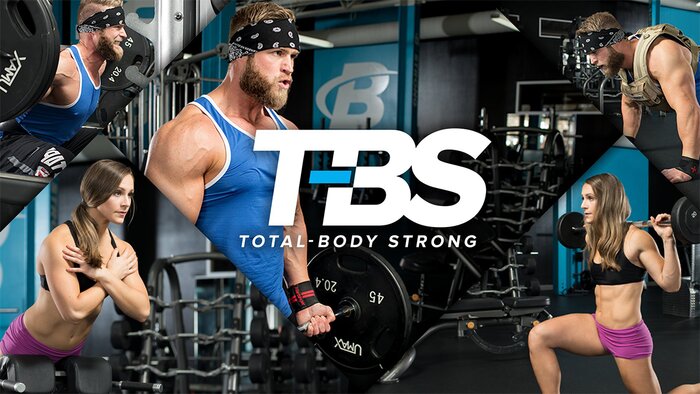Products You May Like
There are plenty of ways to measure progress in the weight room—or, for that matter, in your home gym. How much you can hoist for a single max-effort rep on a given lift is one, of course, although it’s one that most of us can’t (and shouldn’t) measure every time we train. Rep maxes is another—say, how much you can handle for a hard set of 6-8, or how many reps you can do of a staple move like pull-ups. The total amount of weight you lifted in a certain exercise or in a certain workout is yet another.
They’re all valuable in the right time and place. Now here’s one more that you may not have considered: the amount of work you did in a certain period of time. That’s the heart of Escalating Density Training, a training concept I coined nearly 20 years ago and that more people know me for than probably any other technique.
If you’re looking for a single “rule” that defines EDT, it’s this: Do more work than you did last time, and do it in the same period of time. Simple enough, right? And yet there’s something magic about it. Increasing workout density might be the single training variable that pays off most in the most areas: muscularity, strength, fat loss, conditioning, mental toughness—the whole package. But especially muscle gain and fat loss.
The best part? It may also be the most home-training-friendly technique from that list above. No matter if you’re in the gym daily or haven’t seen one in months—or years—you can revolutionize your training with EDT.
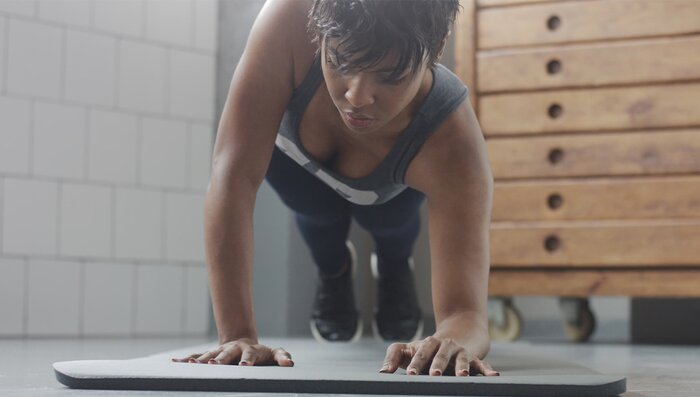
Here’s how to put it to work for you.
Anatomy of a Dense Workout
Traditional EDT training is structured around 15-minute “modules” using a moderate load on two antagonistic or non-competing exercises. A workout usually consists of two modules, and in each one, you rack up as many total reps as possible in the allotted time.
Here’s a quick example of a module.
Training Module 1: Dumbbell incline press / hack squat
Instructions: Perform a few warm-up sets, moving back and forth between both exercises. Identify (or at least estimate) a 10RM load for each movement, and alternate sets of no more than 5 reps for each of those movements for 15 minutes, resting as much as needed but no more.
That’s really it, and you could do pretty well just following those instructions and nothing more. But let’s touch on one detail that can trip people up: the warm-up.
When doing a density-focused workout, do just enough warming up to accomplish two objectives:
- Warming up the muscles and the core body temperature.
- Getting a decent idea what your 10RM is on the two lifts.
Do that and no more—you’ve got a lot on your plate, trust me. And honestly, don’t stress if you’re not sure if you’ve found your “true” 10RM for each exercise. It’s more important that the weight you choose for your working sets is equally difficult for the two movements than that it’s completely accurate.
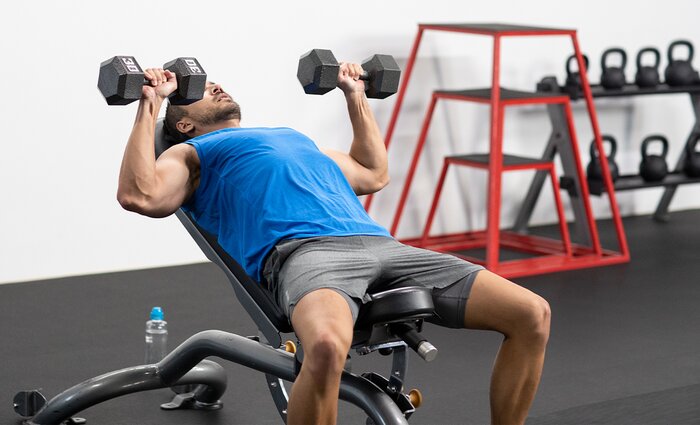
What an EDT Workout Feels Like
Once your working weights have been determined, set a stopwatch to 15 minutes and get ready for an ass kicking. Simply alternate back and forth between each exercise, performing sets of 5 with your 10-rep weight.
Worried about rest? Don’t. At least for your first workout, don’t stress about how long your down time is between sets. It’s not a race, and even if your rest intervals aren’t absolutely optimal, the system will autocorrect you over time.
That said, as the minutes tick by, fatigue will accumulate dramatically. At the start, you’ll easily be able to manage sets of 5 where 10 were possible. Five or six minutes in however, your momentary RMs will have eroded from 10 to maybe 6-7. If you continue to do 5, your total numbers will suffer, so drop your reps accordingly to 4, then 3, and so on.
Basically, do what you need to do to keep working.
One key objective of EDT is learning to focus on the big picture: It’s total work that really matters, not what you do during any single set.
By the time you reach the last 1-2 minutes, you’ll likely be struggling with singles and doubles. Once the 15 minutes has elapsed, you’re left with a total number of reps performed on each exercise. It might be 30, 40, 50, or even more.
The next time you perform this workout, you have a very simple objective: Perform more reps than you did last time, using the same weights, and in the same time limit.
When you achieve this, you will have increased your training density.
You Must Earn Your Weight Increases!
“When should I add weight?” It’s an unavoidable question, so here’s a systematic answer.

Rinse and repeat, workout by workout, until you reach a total number of reps that exceeds your original number by 20 percent or more. Here’s a hypothetical example of such a progression:
- Session 1: 48 total reps
- Session 2: 55 total reps
- Session 3: 58 total reps
On this third session, you’ve increased your reps more than 20 percent from baseline, so on the following session, you now have the honor of increasing the weight on both exercises by 5 pounds or 5 percent (whichever is less). Then rinse and repeat again. Establish a new PR for these new weights, and on subsequent outings, work toward exceeding this number by 20 percent or more, then increase weight again.
When you follow this procedure, not only will you experience mind-numbing pumps and alarming levels of DOMS, you’ll also be increasing your work capacity, gradually increasing the total amount of work you can accomplish per unit of time.
Applying EDT To Your Current Workouts
There are three fundamental ways to integrate EDT into your own training:
- Apply EDT to every exercise in every workout for a given training cycle, for something like 4-8 weeks.
- Apply EDT to your “assistance” exercises in every workout for a given training cycle. Let’s say you compete in powerlifting (or at least train like you do) and you love the Westside method. Simply perform your “core” exercises using conventional heavy loading, such as 5×5, and then use EDT for the other parts of your workout.
- Use EDT on specific training days. For example, perhaps you love undulating periodization, where you use a different rep zone for each workout. Simply use EDT for the high-rep workout of your current program.
Now, I know you want to see what an EDT training week looks like, and I’m more than happy to oblige. Just remember to think of each of these movements as a pattern—squat, vertical press, horizontal pull, etc.—and to substitute along those lines based on the equipment you have. That’s how I advise programming in my BodyFit program Total-Body Strong, and it works perfectly here, as well.
Day 1
- First Module: Back squat/Flat dumbbell bench press
- Second Module: Low cable row/Lying triceps extension
Day 2
- First Module: Leg press/Pull-up
- Second Module: Weighted back extension/Dip
Day 3
- First Module: Romanian deadlift/Military press
- Second Module: Hack squat/T-bar row
The Best Exercise Pairings for Density Training

The exercises used in each module should be as different as possible in terms of muscular topography. Ideally, choose pairs of either an upper/lower or pulling/pushing movement for each module. Here are just a few examples of effective EDT exercises pairings that aren’t in the workout above:
Upper/Lower:
- Bench press/leg extension
- Back extension/military press
Pushing/Pulling:
- Dip/chin-up
- Bench press/low cable row
- Lying triceps extension/standing dumbbell curl
Anterior/Posterior Chain:
- Leg extension/leg curl
- Goblet squat/hip thrust
- Front squat/back extension
- Hack squat/good morning
Muscles far apart from one another:
- Triceps push-down/standing calf raise
- EZ-bar curl/weighted crunch
- Barbell shrug/seated calf raise
- Lateral raise/seated leg curl
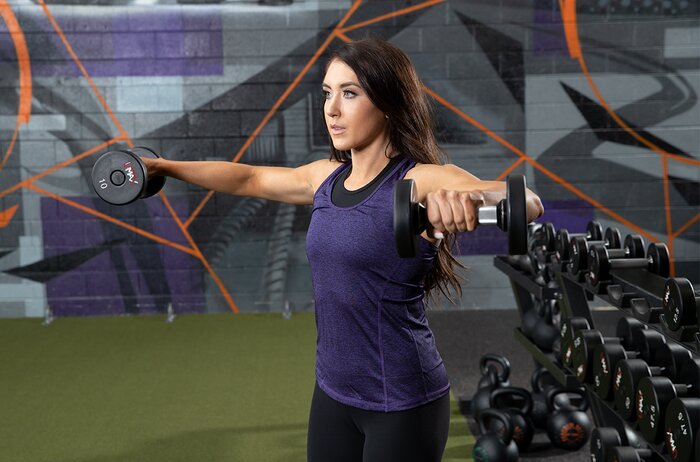
Some exercises aren’t particularly well suited to the frantic barbarity of an intense EDT session: Olympic lifts come to mind, but any lift that you find technically challenging should be saved for other styles of training.
Does EDT work with a split?
Yes and no. If you try to pair two movements that target the same muscle in density training—say, pull-ups and curls, leg extensions and back squats, or dumbbell flyes and bench press—you won’t last long. Call when you need help getting out from underneath the bar.
That said, if your split has you doing workouts along the lines of chest and back (Arnold’s favorite back in the day), biceps and triceps, legs and shoulders, or upper body one day and lower the next, then it can be a perfect fit.
What if I can’t hold a piece of equipment for 15 minutes straight?
Depending on what exercises you choose, EDT can be tough to pull off in busy gym settings. After all, you’re “on the clock” while some brah is parked on your next station texting his girlfriend.
There are a few workarounds for this. First, if at least one exercise per paring is a bodyweight drill, you obviously aren’t using any equipment that anyone can deprive you of. Also, if at least one exercise in a pairing is a dumbbell movement, you can carry them over to whatever station you’re using for the second exercise, which will provide you with more control over the equipment you need.
Conversely, if someone seems annoyed that you see to be hogging two different stations, just say, “Sorry, I’ll be done in 4 minutes and 13 seconds.” That usually serves to reduce the tension.
Is density training good for home training?
Absolutely. In fact, it may be better for home training than for a gym. Because you’re never using a weight that you can’t theoretically handle for 10 reps, you don’t need as many different weights as for most other programs. And low-equipment movements like dips, pull-ups, and dumbbell moves work perfectly with EDT.
An added bonus: If you’re someone who can only do 10ish push-ups, EDT can help you get that number way up in a few weeks.
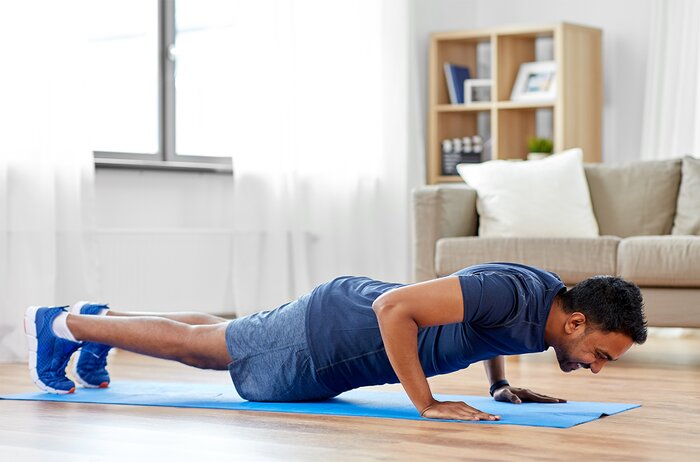
Can I do 20-minute modules?
People who have never done EDT are usually the ones to ask this question. But once they’ve tried EDT, they ask if it’s all right to use 10-minute time intervals. Yes, feel free to tweak the rules, but first, actually use those rules so you know what you’re dealing with.
What about single-arm or single-leg movements?
Unilateral drills are slightly “messy” for EDT applications. But if you’re doing home workouts in particular it may be your best choice. If you decide to use a single-leg or single-arm movement, pair the left and right sides as one pairing.
How long should I do EDT for?
Like all good things, training programs must eventually come to an end. That’s OK; it means you’ve made progress.
When you find that you’re no longer able to improve your numbers, or you’re just fried from the relentless intensity, switch to a different training style for a while, and come back to EDT later.
Lift Like an Artist
One reason I love EDT is that it forces you to think purely in terms of productivity and focus on outcomes rather than methods.
To fully appreciate this, imagine that you’re a writer, artist, or musician. In order to get better at what you’re doing, you simply must work (or practice) as much as possible given whatever time constraints you’re operating under. You focus on your production, not the fatigue it inevitably produces. When your production begins to suffer appreciably, you rest, recover, and get back to work.
Conversely, because lifters associate pain with progress, they all too often do just the opposite: They seek out fatigue, even though it means they end up accomplishing less total work. Fatigue becomes their goal, rather than a side effect. This is never seen in any pursuit but lifting.
Now don’t miss my point here. If you’re doing EDT properly, you’ll experience plenty of pain and fatigue, but it isn’t the goal. Being able to do more work is the goal. When your performance improves, you’ve improved.

